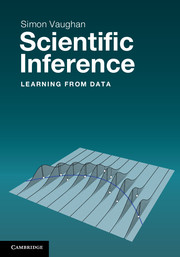Book contents
- Frontmatter
- Dedication
- Contents
- For the student
- For the instructor
- 1 Science and statistical data analysis
- 2 Statistical summaries of data
- 3 Simple statistical inferences
- 4 Probability theory
- 5 Random variables
- 6 Estimation and maximum likelihood
- 7 Significance tests and confidence intervals
- 8 Monte Carlo methods
- Appendix A Getting started with statistical computation
- Appendix B Data case studies
- Appendix C Combinations and permutations
- Appendix D More on confidence intervals
- Appendix E Glossary
- Appendix F Notation
- References
- Index
7 - Significance tests and confidence intervals
Published online by Cambridge University Press: 05 June 2014
- Frontmatter
- Dedication
- Contents
- For the student
- For the instructor
- 1 Science and statistical data analysis
- 2 Statistical summaries of data
- 3 Simple statistical inferences
- 4 Probability theory
- 5 Random variables
- 6 Estimation and maximum likelihood
- 7 Significance tests and confidence intervals
- 8 Monte Carlo methods
- Appendix A Getting started with statistical computation
- Appendix B Data case studies
- Appendix C Combinations and permutations
- Appendix D More on confidence intervals
- Appendix E Glossary
- Appendix F Notation
- References
- Index
Summary
About thirty years ago there was much talk that geologists ought only to observe and not theorize, and I well remember someone saying that at this rate a man might as well go into a gravel-pit and count the pebbles and describe the colours. How odd it is that anyone should not see that all observation must be for or against some view if it is to be of any service!
Charles Darwin (letter to Henry Fawcett, 18 September 1861)How do we know if the model fitted to our data is actually a good match to the data? And how do we quantify the uncertainty on the estimates of the model's parameters? The first question can be addressed by significance testing, and the second can be answered using confidence intervals.
A thought experiment
We shall return to the thought experiment begun in Chapter 5, drawing from a bag containing sweets of two colours, red and green. But now let us imagine that we do not know the proportions of red and green sweets. Instead, we are allowed to draw 10 times from the bag, with replacement. A simple hypothesis is that the bag contains equal numbers of red and green. What do we say about this hypothesis if we get eight greens from our 10 draws?
Let's assume the bag contains equal proportions, and find the probability for getting data like ours.
- Type
- Chapter
- Information
- Scientific InferenceLearning from Data, pp. 142 - 168Publisher: Cambridge University PressPrint publication year: 2013



